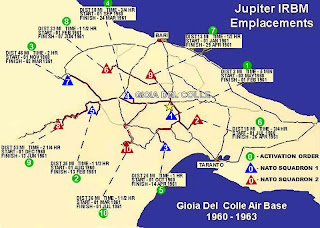Jupiter on display at the National Museum of the United States Air Force, Ohio
This is where all nuclear missiles belong, in museums around the world where human population can scorn their discovery and use. Like, why did humanity ever allow this?
Miss Baker and Miss Able were the two squirrel monkeys the USA successfully launched into space on this rocket and returned alive. Yes, there were others that did not arrive alive.
This rocket was also used for less peaceful purposes.
Below is a picture of the same missile, stationed in Italy. There were emplacements in Turkey as well.
Jupiter missile emplacement showing ground support equipment. The bottom third of the missile is encased in a "flower petal shelter" of wedge-shaped metal panels allowing crews to service the missile in all weather conditions.
This is where all nuclear missiles belong, in museums around the world where human population can scorn their discovery and use. Like, why did humanity ever allow this?
Miss Baker and Miss Able were the two squirrel monkeys the USA successfully launched into space on this rocket and returned alive. Yes, there were others that did not arrive alive.
This rocket was also used for less peaceful purposes.
Below is a picture of the same missile, stationed in Italy. There were emplacements in Turkey as well.
Jupiter missile emplacement showing ground support equipment. The bottom third of the missile is encased in a "flower petal shelter" of wedge-shaped metal panels allowing crews to service the missile in all weather conditions.
- Republic of Italy (This information is on Wikipedia)
- Headquarters: Gioia del Colle Air Base Warhead store 40°55′29.78″N 16°37′34.87″E Fissile pit store
40°47′6.74″N 16°55′33.5″E - Squadron 1
- Site1
- 40°44′24.59″N 16°55′58.83″E
- Site 3 40°35′42.00″N 16°51′33.00″E
- Site 4 40°48′47.05″N 16°22′53.08″E
- Site 5 40°45′32.75″N 16°22′53.08″E
- Site 7 40°57′43.98″N 16°10′54.66″E
- Squadron 2
- Site 2 40°40′42.00″N 17°6′12.03″E
- Site 6 40°58′6.10″N 16°30′22.73″E
- Site 8 40°42′14.98″N 16°8′28.42″E
- Site 9 40°55′23.40″N 16°48′28.54″E
- Site 10 40°34′59.77″N 16°35′43.26″E
- Turkish Republic
- Headquarters: Cigli Air Base
- Warhead and fissile pit stores 38°31′17.32″N 27°1′3.89″E
- Site 1 38°42′26.68″N 26°53′4.13″E
- Site 2 38°42′23.76″N 27°53′57.66″E
- Site 3 38°50′37.66″N 27°02′55.58″E
- Site 4 38°44′15.13″N 27°24′51.46″E
- Site 5 38°47′30.73″N 27°42′28.94″E
- Populous cultural history in the USA paints a slightly different picture than the facts regarding the Cuban Missile Crisis. It paints a USA under siege by Russia. That is not completely the case. Russia was being surrounded by nuclear capacity in near border regions and it didn't appreciate it. That was occurring before they placed missiles in Cuba.
- Khrushchev (click here) would respond to the naval blockade and U.S. demands. But the leaders of both superpowers recognized the devastating possibility of a nuclear war and publicly agreed to a deal in which the Soviets would dismantle the weapon sites in exchange for a pledge from the United States not to invade Cuba. In a separate deal, which remained secret for more than twenty-five years, the United States also agreed to remove its nuclear missiles from Turkey. Although the Soviets removed their missiles from Cuba, they escalated the building of their military arsenal; the missile crisis was over, the arms race was not.
- It is not a big secret. The reality the USA had a nuclear capacity in Turkey is in the JFK library. It is generally not put into that context in populous American culture of war, though.
- The Cold War did not assassinate John F. Kennedy, Vietnam did.
- History also paints Khrushchev as a war monger and angry Soviet leader. In many ways, his muscle flexing made the USA pay attention to their encroachment on the Russian people. I am not quite sure history has done justice to Nikita Khrushchev in his effectiveness to reign in nuclear war.


